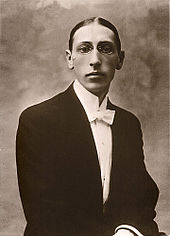“I have learned throughout my life as a composer chiefly through my mistakes and pursuits of false assumptions,
not by my exposure to founts of wisdom and knowledge.”
AUTHOR: Igor Stravinsky
MEANING OF THE QUOTE:
“Wisdom and knowledge are developed through lessons learned from making mistakes.”
COMPOSER
IVES
IVES
Three Places in New England
01. THEORY:
.......a. PASSED OUT NEW THEORY PACKET: STEPWISE MOTION and NOTE READING
............1. WENT OVER FIRST PAGE IN CLASS
............2. DISCUSSED THAT A STEP IN MUSIC NOTATION IS WHEN YOU GO FROM A LINE NOTE TO THE
NEIGHBORING SPACE NOTE EITHER UP or DOWN
02. WROTE FINAL DRAFT ON PARAGRAPH ABOUT AUDIENCE ETIQUETTE AT DIFFERENT VENUES
ADV. STRINGS
[SPRING CONCERT (THURSDAY; MAY 30TH) PREPARATION]
01. PARADISE
02. HOUDINI
03. YOU'VE GOT A FRIEND IN ME
BEG. STRINGS
[SPRING CONCERT (THURSDAY; MAY 30TH) PREPARATION]
01. WHAT MAKES YOU BEAUTIFUL (MELODY)
03. YOU'VE GOT A FRIEND IN ME
BEG. STRINGS
[SPRING CONCERT (THURSDAY; MAY 30TH) PREPARATION]
01. WHAT MAKES YOU BEAUTIFUL (MELODY)
02. SABOR A MI (HARMONY)
03. YOU'VE GOT A FRIEND IN ME (MELODY)
03. YOU'VE GOT A FRIEND IN ME (MELODY)
PROGRAM NOTES FROM THE SCOTTISH CHAMBER ORCHESTRA:
Ives - Three Places in New England
Charles Ives (1874-1954)
Three Places in New England
Three Places in New England
The ‘St Gaudens' in Boston Common (Col. Shaw and his Colored Regiment)
Putnam's Camp, Redding, Connecticut
The Housatonic at Stockbridge
Putnam's Camp, Redding, Connecticut
The Housatonic at Stockbridge
Some years ago the news was full of speculation that trees absorb sound as they grew – and with the right apparatus we could tap into this woody archive and listen in to history. It was a silly season tale, butThree Places in New England has something of the quality of what we might have heard: it is a reflection on American history and place through sound.
Ives created the piece in 1913-14, but found it impossible to get a performance. Sixteen years later he was still trying, and even the International Society for Contemporary Music turned it down. So, being a wealthy man, he took matters into his own hands and paid for the premiere himself. Then toured Europe with it – to great acclaim. Each movement has a poem or prose introduction that clearly tells of Ives’ intentions. They are the best keys to the piece.
‘St Gaudens’ fuses celebrated battle songs (Battle Cry of Freedom, Marching through Georgia and Stephen Foster’s Old Black Joe) with spirituals (Jesus Loves Me) to create a musical comment on America’s attitude to race and colour. The preface goes:
Moving-Marching-Faces of Souls!
Marked with generations of pain,
Part-freers of a Destiny,
Slowly, restlessly-swaying us on with you
Towards another Freedom!
The man on horseback, carved from
A native quarry of the world Liberty
And from what your country was made.
You images of a Divine Law
Carve in the shadow of a saddened heart-
Never light abandoned-
Of an age and of a nation.
Above and beyond that compelling mass
Rises the drum-beat of the common-heart
In the silence of a strange and
Sounding afterglow
Moving-Marching-Faces of Souls!
Putnam’s Camp is a play of memories in the mind of a child at a picnic:
Marked with generations of pain,
Part-freers of a Destiny,
Slowly, restlessly-swaying us on with you
Towards another Freedom!
The man on horseback, carved from
A native quarry of the world Liberty
And from what your country was made.
You images of a Divine Law
Carve in the shadow of a saddened heart-
Never light abandoned-
Of an age and of a nation.
Above and beyond that compelling mass
Rises the drum-beat of the common-heart
In the silence of a strange and
Sounding afterglow
Moving-Marching-Faces of Souls!
Putnam’s Camp is a play of memories in the mind of a child at a picnic:
Near Redding Center is a small park preserved as a Revolutionary Memorial; for here General Israel Putnam’s soldiers had their winter quarters in 1778-1779. Long rows of stone camp fire-places still remain to stir a child’s imagination. The hardships which the soldiers endured, and the agitation of a few hot-heads to break camp and march to the Hartford Assembly for relief, is a part of Redding history.
Here you hear both the picnic jollity and darker music of war – the child’s mind wanders further and further from the present, ultimately to a vision of the Goddess of Liberty. At the close he returns to the bright brass bands of the picnic. Among the tunes Ives plays with are Arkansas Traveler, Hail! Columbia, Massa’s in de Cold Ground, The Star Spangled Banner, Yankee Doodle and Semper Fidelis.
The Housatonic had its inspiration at one of the happiest times in Ives’ life. Shortly after their honeymoon in 1908, he and his wife Harmony walked along the Housatonic river in Massachusetts: “We walked in the meadows along the river, and heard the distant singing from the church across the river. The mist had not entirely left the river bed, and the colors, the running water, the banks and elm trees were something that one would always remember.”
© Svend Brown

